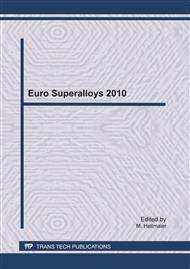p.454
p.460
p.466
p.472
p.479
p.485
p.491
p.497
p.503
Mechanical Properties of New Ni-Mn-Based Braze Alloys for the Fast Epitaxial Braze Repair of Single-Crystalline Ni-Base Superalloys
Abstract:
Diffusion brazing is a widely-used technology for the repair of cracks in hot section turbine components, mostly fabricated from single-crystalline Ni-based superalloys. Typically, braze alloys with a composition similar to the base material, enhanced by fast diffusing melting point depressants like B are used. If single-crystalline (SX) components are repaired, an epitaxial healing can be achieved, however, the filling of wide cracks in the range of 100-300 μm is difficult, since the process is completely diffusion controlled which means that wide cracks require very long hold times. If the temperature is lowered before a complete isothermal solidification has been awaited, the poor solubility of B in Ni leads to the precipitation of borides, serving as nucleation sites for stray grains. Thus, especially for the repair of wide cracks, new Ni-Mn-based braze alloys were developed which allow a very fast epitaxial healing. As B is replaced by Mn, the repair process can be significantly shortened since the epitaxial solidification is no longer diffusion controlled but can be enforced by cooling. This is due to the fact that Ni and Mn are almost completely miscible which means that the precipitation of secondary phases during solidification is eliminated. The Ni-Mn-based braze alloys were enhanced by Al, Cr and Ti to provide a sufficient high temperature strength and an appropriate oxidation behavior. Furthermore, heat treatment cycles have been developed producing a γ / γ’-microstructure very similar to the base material. In this work, results from mechanical testing of wide-gap samples which were filled with the new braze alloys are presented and discussed.
Info:
Periodical:
Pages:
479-484
Citation:
Online since:
July 2011
Authors:
Permissions:
Share:
Citation:


